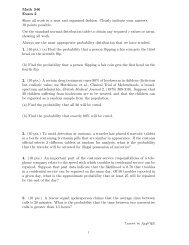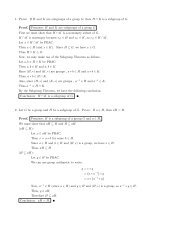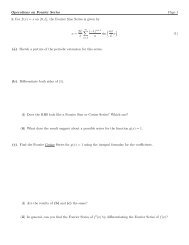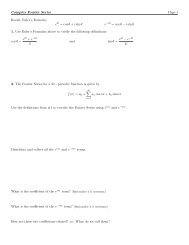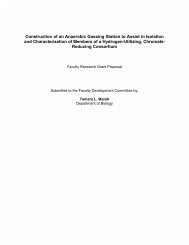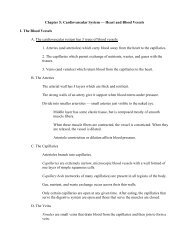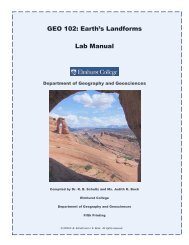Free Executive Summary - Elmhurst College
Free Executive Summary - Elmhurst College
Free Executive Summary - Elmhurst College
You also want an ePaper? Increase the reach of your titles
YUMPU automatically turns print PDFs into web optimized ePapers that Google loves.
Learning to Think Spatially: GIS as a Support System in the K-12 Curriculum<br />
http://www.nap.edu/catalog/11019.html<br />
SPATIAL THINKING IN EVERYDAY LIFE, AT WORK, AND IN SCIENCE 87<br />
was a tear in the continuity of the profile. For an area of rugged terrain therefore, Tharp could not<br />
see the shape of the seafloor by looking directly at the shipboard data.<br />
The actual display on the graphic recorded in the ship showed the fractional part of the acoustic<br />
travel time in seconds. The integer part of the travel time was not displayed directly, but had to be<br />
“book-kept” by keeping track of the upward and downward changes of sweep. In other words,<br />
every 0.5 second of travel time (200 fathoms) looks in the shipboard data exactly like 1.5 seconds<br />
of travel time (600 fathoms) and 2.5 seconds (1,000 fathoms). If the shipboard watchstanders did<br />
not bookkeep accurately, the water depth could easily be off by 400, 800, or more fathoms.<br />
To ensure that some of the outgoing acoustic energy traveled downwards toward the seafloor<br />
despite the rolling and pitching of the ship, echo sounders of Tharp’s era emitted a 60 degree wide<br />
cone of sound, rather than a narrowly focused beam. In steep terrain such as a mid-ocean ridge<br />
crest, the first returning echo might be from a point off to the side of the ship rather than directly<br />
beneath the ship. In that case a mass of overlapping “side echoes” could partially or totally obscure<br />
the vertical seafloor echo on the data record.<br />
The ship tracks that Tharp worked with were irregularly spaced opportunistic crossings of the<br />
central Atlantic rather than the results of a systematic survey. The gaps between ship tracks were<br />
often large (hundreds of kilometers) relative to the size of the features being mapped, requiring<br />
rather bold interpolation between tracklines. The ships’ navigation was by celestial navigation and<br />
dead reckoning. The charted positions of the ships could be off by miles in any direction. Consequently,<br />
the bathymetric data on crossing tracks often did not agree.<br />
The intellectual challenge was in one sense the problem to be solved. There was no conceptual<br />
framework with which to guide the eye toward detecting spatial patterns in the data. There were few<br />
expectations as to what might or even could exist. The processes by which seafloor morphology is<br />
formed were almost completely unknown. There was no way of knowing, at the beginning of the<br />
work, where or when the process would end, and there were few guides as to where to begin looking<br />
for pattern and meaning. One obvious source, continental geomorphology, was in fact misleading.<br />
As it turned out, seafloor morphology is shaped by quite different processes than those that dominate<br />
in continental settings, and as a result, there are no familiar land surface analogues for many<br />
seafloor bathymetric features.<br />
3.7.5 Marie Tharp: A Skillful Spatial Thinker at Work<br />
In creating maps of the seafloor, Marie Tharp epitomizes the skillful spatial thinker at work.<br />
We can see many of the dimensions of skilled performance. In doing so, it is important to reemphasize<br />
the extent to which she worked with limited technological support. Many of the tasks<br />
that she undertook with paper and pencil would today be supported by technology.<br />
A skilled spatial thinker is capable of detecting spatial patterns and regularities from a sparse,<br />
discontinuous, and error-laden data set. Even today, it would be a challenge for a geoscientist,<br />
knowledgeable about the processes that shape seafloor morphology, to generate sensible seafloor<br />
contours from the scattered ship tracks that Tharp had available. A skilled spatial thinker can depict<br />
and interpret spatial information despite noisy, ugly data. Tharp literally saw through the masses of<br />
side echoes and navigation errors in her data set.<br />
Part of her success is a reflection of another component of spatial thinking. She could shift<br />
easily back and forth among different vantage points and representations of spatial data. Tharp’s<br />
raw data were profiles; her intermediate products were lines of tiny handwritten numbers; and her<br />
final products were maps and paintings.<br />
A skilled spatial thinker is also creative in terms of using or, more significantly, creating new<br />
representational modes to convey spatial data. When the U.S. Navy prohibited Heezen and Tharp<br />
Copyright © National Academy of Sciences. All rights reserved.



